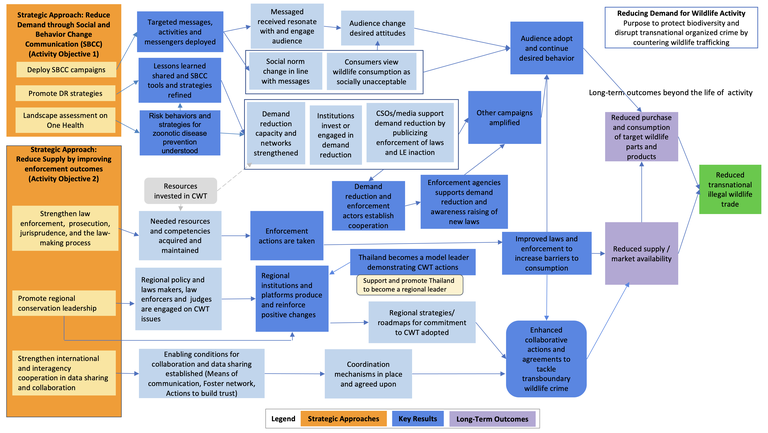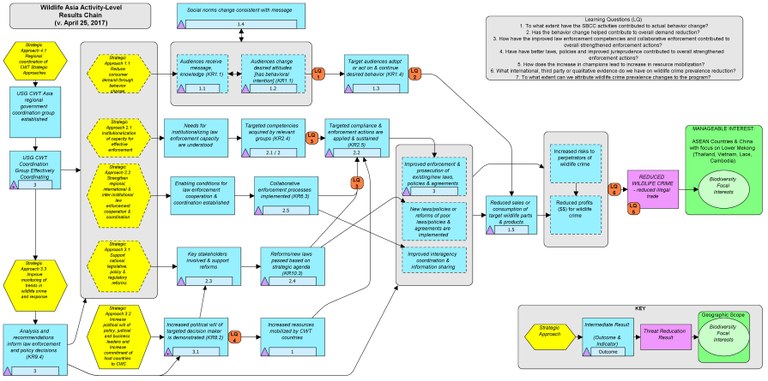About Us
The U.S. Agency for International Development (USAID) works to end wildlife trafficking, focusing on elephants, rhinos, tigers, and pangolins, which are among the top species illegally traded in global wildlife trafficking “hotspots”. Working closely with the Association of Southeast Asian Nations (ASEAN), USAID Reducing Demand for Wildlife (RDW) addressed wildlife trafficking as a transnational crime in Southeast Asia and China, where organized wildlife crime has decimated wildlife populations, spread zoonotic diseases, and destroyed opportunities for local community wildlife-based livelihoods. The program worked with lawmakers, law enforcement bodies, and regional and local partners to reduce the demand as well as the supply of illegal wildlife products in accordance with the U.S. Government’s Eliminate, Neutralize, and Disrupt Wildlife Trafficking Act of 2016 (END Act) and the U.S. Presidential Executive Order on Enforcing Federal Laws with Respect to Transnational Criminal Organizations and Preventing International Trafficking 2017.
RDW built on the USAID Wildlife Asia program, a $24.5 million regional initiative that ran from 2016-2021. USAID Wildlife Asia pioneered evidence-based and targeted demand reduction campaigns, leading to a 50 percent drop in the proportion of people intending to buy wildlife products in Thailand, Vietnam, and China. The program also advanced ten counter wildlife trafficking laws and policies that introduced dramatic increases in fines and sentencing for wildlife crime, mainstreamed the collaborative approach among law enforcement agencies to countering transnational organized wildlife crime, and trained over 125 law enforcement agencies from 24 countries across Asia and Africa. To address the continued threat of illegal wildlife trade in the region, as well as new and emerging challenges in a post-COVID19 world, USAID also helped catalyze more effective and impactful collaboration and regional integration of counter wildlife trafficking efforts through the Counter Wildlife Trafficking (CWT) Development Partners Coordination Platform for Asia, which continued under RDW.
RDW helped reduce demand for wildlife parts and products and promoted the social and behavior change communication (SBCC) approach. It also advanced knowledge and understanding of an integrated approach to CWT, while advancing regional coordination and partnership. Working with partners in government, NGOs, and the private sector, RDW supported development and institutionalization of new tools and technologies to increase the effectiveness of CWT efforts.
USAID Wildlife Asia pioneered evidence-based and targeted demand reduction campaigns using SBCC. It also advanced ten counter wildlife trafficking laws and policies that introduced dramatic increases in fines and sentencing for wildlife crime, mainstreamed the collaborative approach among law enforcement agencies to countering transnational organized wildlife crime, and trained over 125 law enforcement agencies from 24 countries across Asia and Africa. You can find campaign materials, innovative tools, research, and other resources developed during both RDW and USAID Wildlife Asia in this section.
REDUCING DEMAND FOR WILDLIFE (2021-2023)
OBJECTIVES
-
Reduce Demand through Social and Behavior Change Communication. The Activity continued USAID Wildlife Asia’s pioneering use of social and behavior change communication (SBCC) as an approach to shift attitudes, social norms, and purchase intent to further reduce demand for wildlife products. USAID Wildlife Asia demonstrated that the SBCC approach, including the five-step planning process, is effective in significantly changing desired attitudes, social norms, and intention to use wildlife products. Since most of these campaigns ran for an average of less than one year and were limited in geographic scope, more needs to be done to further increase desired attitudes and social unacceptability, and to reduce intention to buy wildlife products. RDW continued and expanded the learning component implemented under USAID Wildlife Asia to advance SBCC approaches and promote use of SBCC in demand reduction as a pillar of counter wildlife trafficking.
-
Reduce supply by improving enforcement outcomes through rational, comprehensive regulatory and enforcement systems. Deploying SBCC campaigns alone would not achieve counter wildlife trafficking goals. Regulatory and enforcement systems must also function to support demand reduction efforts. In this context, it was critical to account for changes over the previous decade in the regulatory and enforcement systems countering wildlife trafficking, particularly law enforcement agencies coming to see wildlife trafficking as a serious crime that deserved time and resources. To complement demand reduction efforts with strengthened supply side capacities, RDW promoted conservation leadership, strengthened the connection between links of the policy-enforcement-adjudication chain, and strengthened interagency and international cooperation and collaboration.
THEORY OF CHANGE
The Activity’s purpose or highest-level result was achieved through anticipated results based on the strategic approaches. This Theory of Change demonstrates the linkages to improve regional action to end wildlife crime through increasing risks to perpetrators of wildlife crime and reducing profits for those that engage in wildlife crime. The assumption is that by accomplishing all of the below, it will be possible to improve regional action to end wildlife crime.
- Consumer demand is reduced through the use of effective SBCC methodologies.
- Demand reduction strategies are adopted and applied regionally.
- The impacts of the global pandemic on demand is understood.
- Law enforcement, prosecution, jurisprudence and law making processes are advanced.
- Regional conversation leadership is promoted.
- International and interagency cooperation, data sharing, and collaboration is enhanced.
The RDW Theory of Change is depicted in the Activity-level Results Chain diagram below.

Reducing Demand for Wildlife Theory of Change Diagram - full image
USAID WILDLIFE ASIA (2016-2021)
OBJECTIVES
- Reduce Consumer Demand - USAID Wildlife Asia implemented an innovative and evidence-based SBCC approach to change practices and build new social norms around the use of wildlife products. Activities included targeted behavior change campaigns and partnering with influential wildlife champions to help amplify demand reduction messages.
- Strengthen Regional Law Enforcement - Working with Interpol, ASEAN National Police, and the ASEAN Working Group on the Convention on International Trade in Endangered Species and Wildlife Enforcement, USAID Wildlife Asia trained regional police, customs officers, and prosecutors to effectively locate, apprehend, and prosecute illegal wildlife traffickers. The project also brought together enforcement authorities in Asia and Africa to collaborate in dismantling transcontinental trafficking syndicates.
- Enhance Political Commitment and Support - USAID Wildlife Asia promoted countries’ commitment to end wildlife crime by working with key government counterparts, Supreme Courts, the ASEAN Inter-Parliamentary Assembly, and judicial and legislative champions to improve respective legal and policy frameworks, share legal and policy innovations and good practices, and harmonize legislation and penalties for wildlife crimes.
- Support Regional Cooperation - USAID Wildlife Asia supported END Act focus countries and the U.S. Inter-Agency Counter Wildlife Trafficking Strategies, and brought together external counter wildlife trafficking stakeholders from across the region in major counter wildlife trafficking initiatives.
THEORY OF CHANGE
The USAID Wildlife Asia Theory of Change is depicted in the Activity-level Results Chain diagram below.


